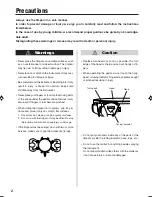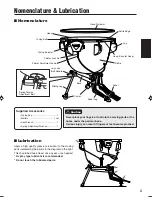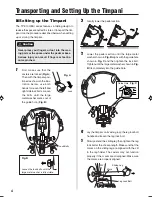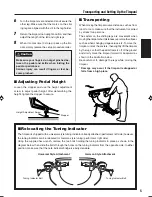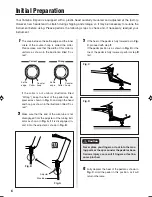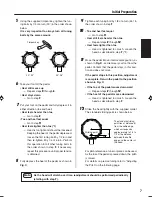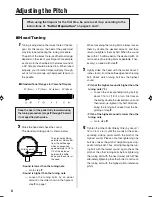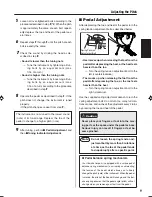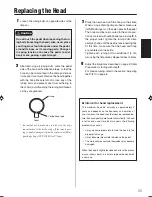
10
■
Tuning Indicator Adjustment
The tuning indicator shows where to set the pedal for each note. After tuning the instrument, you must set each note
on the indicator to its proper position.
Adjusting the Pitch
1
After you have tuned your timpani to the lowest
note of its tonal range, make sure that the pointer
is located within 10 mm from the pedal-side end
of the indicator rail.
* If not, refer to “Adjusting the Pointer Position”.
2
Slide the lowest note of the indicator (“A” in the
case of a 26" timpani—see “Standard Tonal
Ranges for Yamaha Timpani” on page 8) to the
position where its center line coincides with the
pointer.
3
Tune the instrument to the next higher pitch (note)
by moving the pedal, and then slide the corre-
sponding note on the rail to the respective pointer
position. Repeat for each remaining note.
Indicator rail
Pointer
Indicator rail
Note
Note
Pointer
Adjuster
Adjuster nut
●
Adjusting the Pointer Position
First loosen the pointer lock nut and then turn the ad-
juster as follows:
• Pointer is located beyond the lower rail end
when the heel of the pedal is lowered fully (low-
est note).
→
Turn the adjuster to the left (counter clockwise)
until the pointer is aligned with the lowest note
of the indicator.
• Pointer moves beyond the upper rail end before
the toe of the pedal reaches the end of its stroke,
or Pointer does not reach the lower rail end
when the heel of the pedal is lowered fully (low-
est sound)
→
Turn the adjuster to the right (clockwise) to
correct the pointer position as required.
tp3100ea_en_om.6pm
08.2.5, 9:28 AM
10


